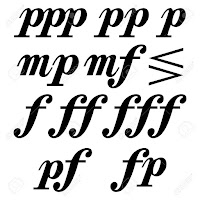Learning about Tempo and Dynamics
 |
| Metronome Marking |
Tempo is often indicated by a specific metronome marking and/or by musical terms written in the music, usually in Italian.
 |
| Metronome |
The mechanical (wind up) metronome was the first metronome. Now many of us use digital metronomes or even an app on our cellphone! The metronome was introduced in 1816. In 1817, Beethoven was the first major composer to indicate a specific tempo or metronome marking in his music.
Composers often indicate music tempo with terms written in the music such as Allegro (moderately fast), Largo (broad; slow and dignified), Adagio (slow, but not as slow as largo) Moderato (at a moderate speed), Andante (at a walking pace; moderately slow), Presto (very fast). There are many other terms in Italian and also in other languages. There are also terms that indicate the music should gradually slow down (Rallantando, often abbreviated to Rall.) or speed up (Accelerando).
 |
| Dynamic Markings |
Click here to play a tempo or dynamics (symbols) game from San Francisco Symphony Kids (Flash required).
Little kids might like this fun YouTube video from Music Express Magazine about tempos or these fun videos from Plank Road Publishing's Music K-8 on dynamics and tempo!
Want to try a metronome? Here's a free online metronome from IMusic-School.
For our advanced music students, how many of these tempo markings from Classical Music City do you know?
To learn more, watch these YouTube videos from Odd Quartet about music tempos or from RIAM Learning and Teaching Network about dynamics.
Did you enjoy this free blog post? Consider making a contribution to The Columbia Orchestra here! We appreciate your support!

Comments
Post a Comment